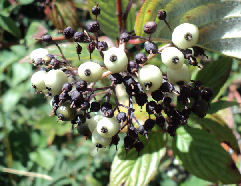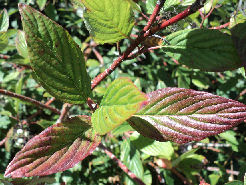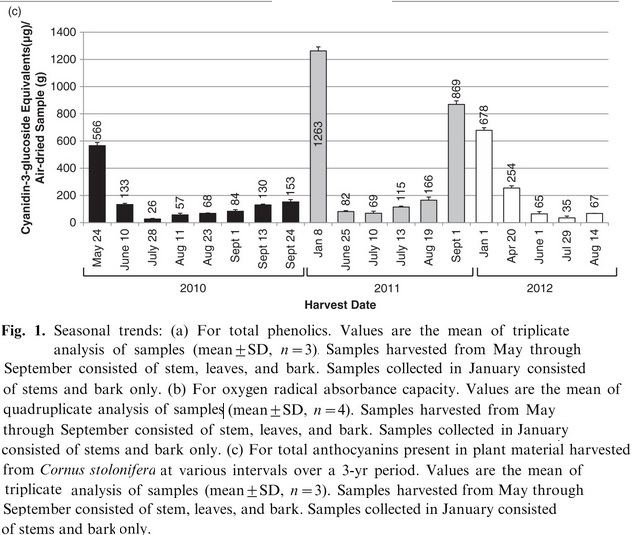|
|
|
|
|
|
| Practical ecological knowledge for the temperate reader. |
Red-osier Dogwood - Cornus stolonifera
- Family: Cornaceae (Dogwood family)
Purgative, Fruit, Seed, Fiber, Wood, Dye, Smoke, Tonic, External Use
Description
Synonyms
|
Cornus alba. [PFAF]
C. alba var. californica (C.A. Mey.) B. Boivin [E-flora]
C. alba var. occidentalis (Torr. & A. Gray) B. Boivin [E-flora]
C. occidentalis. [Turner, Kuhnlein][E-flora]
C. sericea. [Turner, Kuhnlein][PFAF][E-flora][PCBC2004]
C. sericea subsp. sericea [E-flora]
|
C. stolonifera var. californica (C.A. Mey.) McMinn [E-flora]
C. stolonifera var. occidentalis (Torr. & A. Gray) C.L. Hitchc. [E-flora]
C. ×californica C.A. Mey. [E-flora]
Swida stolonifera. [PFAF]
Thelycrania stolonifera. [PFAF]
|
General "a deciduous Shrub growing to 2.5 m (8ft) by 4 m (13ft)."[PFAF] young branches opposite.[IFBC][E-flora] Spreading. [WildPNW]
Flowers White to greenish,[PCBC2004] in an "Inflorescence of flat-topped terminal clusters".[IFBC][E-flora] "The flowers are hermaphrodite (have both male and female organs) and are pollinated by Bees.It is noted for attracting wildlife." [PFAF]
Fruits Small, white to tan, [WildPNW] White (occasionally blue-tinged),[PCBC2004] "Berrylike drupes...each with a somewhat flattened stone."[IFBC][E-flora]
Leaves "Opposite, ...oval, pointed, 4-12 cm long, greenish above, whitish below, turning reddish in the autumn".[IFBC][E-flora] "...mostly sharp-pointed with 5-7 prominent parallel veins that converge at leaf tips".[PCBC2004] "green on both surfaces but paler on the underside". [PWOBC]
Stem "young stems often bright red, especially after a frost." [PCBC2004] "bright red to purplish red stems becoming grayish green with age". [WildPNW]
Habitat "Wet to mesic streamsides, lakesides, swamps and forests".[IFBC][E-flora] Moist soil, rocky shorelines (in Alaska), and disturbed sites. [PCBC2004]
Range Common throughout BC.[IFBC] [E-flora]
Status Native.[IFBC][E-flora]
Similar Species "The variety west of the Coast and Cascade Mountains is sometimes distinguished as C. stolonifera var. occidentalis, or as C. occidentalis." [PCBC2004] "Subsp. occidentalis is rough, hairy. Subsp. sericea is hairless or has few long hairs but is not rough." [WildPNW]
Hazards
- Fruits: This species can spark vomiting and mild symptoms of poisoning.[Schofield] "The fruit can cause nausea[172]." [PFAF]
- Purgative: Use only DRIED bark of C. stolonifera; the fresh shrub bark can be quite purgative to the intestinal tract. The white fruits of American dogwood are not recommended for internal use as they can cause toxic reactions. [Schofield]
Food
- Fruit:
- Harvesting: They were gathered from August to October and eaten fresh, a few at a time.[Turner, Kuhnlein]
- Preparation: "Raw or cooked[105, 161, 257]."[PFAF] Commonly, pounded and mixed with other fruits such as choke cherries or Saskatoons. [Turner, Kuhnlein]
- Preservation: "it was mixed with other fruits such as juneberries (Amelanchier spp) and then dried for winter use by native North Americans[257]" [PFAF]. Some people mashed them and dried them in cakes; others seldom stored them. [Turner, Kuhnlein]
- Properties: "Juicy[101]. Bitter and unpalatable according to some reports[2]." [PFAF]
- Seed: The Lower Lillooet extracted the stones and ate them like peanuts. [Turner, Kuhnlein] "Seed[101]. No more details are given, but the seeds are quite small and woody, looking rather less than edible[K]." [PFAF]
- Oil: "An edible oil is obtained from the seed[4]." [PFAF]
Other Uses
- Basketry: "The branches are pliable, they are used as rims in basket making[99, 257]. The stem wood is very tough and flexible[212]." [PFAF] "Straight stems used for arrows and slender, pliable stems for basketry." [Berries] "The thin, supple wands can be used for basket weaving." [Northern Bushcraft]
- Dogwash: A decoction of the bark has been used as a dog wash. [Schofield]
- Dye: "A red dye can be obtained from the bark mixed with cedar ashes[257]." [PFAF] "The inner bark was mixed with other plants or minerals and used to make a red dye, a light red dye, a black dye, and an ecru or “khaki” colored dye (Densmore 1974)." [USDAPlantGuide]
- Fibre: "Obtained from the bark is used as cordage[99]. The bark can be twisted into a rope[257]." [PFAF] "Twisted pliable branches and strips of shredded bark used to make rope."[Berries]
- Oil: "Obtained from the seed. Burns well and can be used in lighting[4]." [PFAF]
- Shoots: The long, flexible shoots were used for flshpoles, hoop-and-pole game, templates and ribs in canoe construction, and cradle frameworks. [0] [ECIC]
- Smoking Blend: The leaves and/or inner bark were used in smoking mixtures. [Turner, Kuhnlein][Berries] The inner bark was esteemed as a tobacco additive or kinnickinnick ("that which is mixed").[Northern Bushcraft][UAPDS]
- Preparation: They used the leaves to some degree, but mostly the inner bark. They selected both the young and the older twigs that still retained the thin red bark. The soft greenish inner bark was scraped off. Sometimes the inner bark was only partially scraped away and then allowed to hang in shreds. These twigs were toasted before a fire and this inner bark used at once. [Harrington] "When the shavings are dry enough to crumble they are ready to use." [Northern Bushcraft] It was usually mixed with tobacco in various proportions. Two parts of bark used to one of tobacco. [Harrington]
- Properties: It is said to be aromatic and pungent, giving a narcotic effect approaching stupefaction. It certainly should be used in moderation, at least at first. [Harrington] Was smoked by Plains Indians for an effect "similar to opium". [Pharmacotheon]. "It was considered good for any illness relating to the lungs. Mixed with tobacco, it was supposed to cancel out the undesirable effects of nicotine."[Northern Bushcraft]
- Toothpaste: "The powdered bark has been used as a toothpowder to preserve the gums and keep the teeth white[4]." [PFAF]
- Wood: very hard. [Berries]
- Uses: "Natives carved implement handles, cooking tools, barbecue racks, discs for gambling games, and wooden bowls from it." [Berries] "The thicker rods of red osier dogwood were used to make pipe stems." [Northern Bushcraft]
Medicinal Uses
- Bark:Used for colds and fevers. Astringent and good for an after-facial splash, and for steams for oily skin.[Schofield]. "The bark and the root bark are analgesic, astringent, febrifuge, purgative, slightly stimulant and tonic[4, 172, 257]." [PFAF]
- Harvesting: Harvested in spring and fall. [Schofield]
- Preparation: "Drying the bark removes its tendency to purge[172]." [PFAF] Dried. [Schofield]
- Decoction: "A decoction has been used in the treatment of headaches, diarrhoea, coughs, colds and fevers[257]. Externally, the decoction has been used as a wash for sore eyes, styes and other infections and also to treat skin complaints such as poison ivy rash and ulcers[257]." [PFAF]
- Bark decoctions were used as a stimulant.[Pharmacotheon]
- Infusion: "An infusion... was used as an anti-diarrheal by the Chippewa and the Potawatomi, an antidote for weak kidneys by the Shuswap, and a pediatric aid for children who wet the bed by the Shuswap." [USDAPlantGuide] Infusion used for eruptions caused by poison ivy. [USDAPlantGuide]
- "dogwood decoction [taken] after childbirth." [USDAPlantGuide]
- Poultice: "A poultice of the soaked inner bark, combined with ashes, has been used to alleviate pain[257]. The bark shavings have been applied as a dressing on wounds to stop the bleeding[257]." [PFAF]
- Styptic: "The finely-powdered inner bark of kinnickinnick was also sprinkled on runny wounds and gaping cuts as a styptic (a substance that checks bleeding)." [Northern Bushcraft]
- Tonic:
- Berries: Eating a few raw fruits was considered to be a good tonic among the Nlaka'pamux. [Turner, Kuhnlein]
- Bark: The Saanich soaked the bark in warm water and drank as much of the extract as possible to cause vomiting. It cleaned out the stomach and improved breathing. This medicine is still used today by canoe pullers before races (Paul, 1968).[ECSVI]
- Roots: "The roots were dug up in the early spring, and boiled, to make a tonic." [Northern Bushcraft]
Ethnobotany
Medicinal Use
"Red osier dogwood was widely employed by several native North American Indian tribes who valued it especially for its astringent and tonic bark, using it both internally and externally to treat diarrhoea, fevers, skin problems etc[257]. It is little used in modern herbalism. The plant is said to have cured hydrophobia[4]." [PFAF]
- "Leaves and pith were smoked for general well-being and warm bark was used in compresses for swelling or pain by the Carrier people of British Colombia (Ritch-Krc et al. 1996; Tushingham et al. 2013)." [SVPC]
- Roots & Stems:
- Decoction: Native Americans throughout the West made a decoction of plant roots and stems for medicinal purposes. A decoction of the roots and stems "was popular as an eye wash, gynecological aid, "blood medicine" (tonic), cold and fever remedy, laxative, and emetic. Decoction used to heal poison ivy rash and to eliminate thinning hair, itchy scalp, and dandruff."[Berries]
- Fractures: Unspecified part used "to treat fractures, a use not reported elsewhere in the literature." [GMPCCE]
- Leaves: Decoction used for unspecified medicinal uses. [USDAPlantGuide]
- Emetic: "The Navaho-Kayentaf and Navaho Ramah used the plant ceremonially as a Mountaintop-way emetic (Moerman 1986)." [USDAPlantGuide]
- Root: A decoction of the root was used for sore eyes and catarrh. [USDAPlantGuide]
Pharmacology
- Cathartic [USDAPlantGuide]
- Emetic [USDAPlantGuide]
- Laxative [USDAPlantGuide]
- Tonic [USDAPlantGuide]
Phytochemicals
|
[SVPC]
|
[SVPC]
|
|
About 10% of the air-dried stem bark was ethanol-soluble. One of the products obtained (0.07570 yield, based on the weight of bark) was a flavone glycosicle, identifie as hyperin (quercetin- 3-galactoside). In addition to hyperin, the alcohol extract contained fumaric acid, tannins, and a mixture of long-chain fatty acids. The latter mixture was found to consist of n-C24- (66.7%), n-C26- (22.8%), and n-C28-carboxylic acids. In one experiment, when fresh bark was extracted at once, these fatty acids mere obtained only after saponification, showing that hydrolysis inay occur during storage of the plant.[IHCS]
|
Cultivation
"An easily grown plant, it succeeds in any soil of good or moderate fertility[1], ranging from acid to shallow chalk[200]. Grows well in heavy clay soils. Prefers a moist soil and a position in sun or partial shade[108]. Succeeds in poorly drained soils[200]. Plants are hardy to about -35°c[184]. A rampant suckering shrub[1]. A number of cultivars have been developed for their ornamental value[182]. This species is closely allied to C. alba[11]. The flowers are very attractive to bees[108]. Plants in this genus are notably resistant to honey fungus[200]." [PFAF]
Wildlife: Black bears are said to be fond of these "berries". [Turner, Kuhnlein]
Habitat Restoration
|
..."frequently used for waterway bank erosion protection and restoration.... Its root system provides excellent soil retention, it is hardy ... and its ability to be reproduced by cuttings makes it..." economical.[7][8] [Wiki]
"The brush bundles... consisted of fresh cuttings of live red-osier dogwood bundled together with wire. The red-osier dogwoods are used because they quickly establish roots in a stream environment. The red-osier is known to develop excellent root strength." [8][Wiki] (Derived from the primary source material)
"At a location where the erosion was more extreme ..., Kushner installed coir logs. Coir logs consist of tightly bound cylinders of coir (coconut) fiber bound together with netting made from coir twine. Plantings are inside the sleeve of the log. By the time the log dissolves, live plantings have taken root and will protect the bank." [8][Wiki] (Derived from the primary source material)
"Seventh graders pound live willow and red osier dogwood into the erosion blanket that will establish roots to hold the shoreline soil in place. Additional plant plugs (prairie cordgrass and Sprengel’s sedge) that will grow long roots are planted to further stabilize the shoreline." [7][Wiki] (Derived from the primary source material)
|
Groundcover: "Plants can be grown as a tall ground cover for colonising large areas. The cultivar 'Flaviramea' has been recommended[208]." [PFAF]
Propagation
"Seed - best sown as soon as it is ripe in a cold frame or in an outdoors seedbed if there is sufficient seed[80, 113]. The seed must be separated from the fruit flesh since this contains germination inhibitors[80, 164]. Stored seed should be cold stratified for 3 - 4 months and sown as early as possible in the year[164]. Scarification may also help as may a period of warm stratification before the cold stratification[80, 164]. Germination, especially of stored seed, can be very slow, taking 18 months or more[164]. Prick out the seedlings of cold-frame sown seeds into individual pots as soon as they are large enough to handle and grow the plants on for their first winter in a greenhouse, planting out in the spring after the last expected frosts."[78][PFAF]
- "Cuttings of half-ripe side shoots, July/August in a frame. Cuttings of mature wood of the current year's growth, taken with a heel if possible, autumn in a cold frame. High percentage[78]."[PFAF]
- "Layering of new growth in June/July. Takes 9 months[78]."[PFAF]
- "can be started easily by division, french layering ["...a method where a stem is encouraged to develop roots before being removed from the parent plant."], and hardwood cuttings." [USDAPlantGuide]
References
- [E-flora] Cornus stolonifera, http://linnet.geog.ubc.ca/Atlas/Atlas.aspx?sciname=Cornus stolonifera&redblue=Both&lifeform=4 Accessed: 11/13/2014
- [ECIC] Ethnobotany of Chumash Indians, California, Based on Collections by John P. Harrington, JAN TIMBROOK, Economic Botany, 44(2), 1990,pp. 236-253
- [EEPF] Endophytic and epiphytic phyllosphere fungi of red-osier dogwood (Cornus stolonifera) in British Columbia, Osono, Takashi, Mycoscience Volume 48, Issue 1, 2007
- [IHCS] ISOLATION OF HYPERIN FROM RED-OSIER DOGWOOD (CORNUS STOLONIFERA MICHX., G. V. Nair, E. Von Rudloff, Canadian Journal of Chemistry, 1960, 38(12)
- [PFAF] http://www.pfaf.org/user/Plant.aspx?LatinName=Cornus sericea, Accessed Jan 12, 2014
- [SVPC] Seasonal variations in phenolic compounds and antioxidant capacity of Cornus stolonifera plant material: Applications in agriculture, Cara K. Isaak, Jay C. Petkau, O Karmin, Kim Ominski, Juan Carlos Rodriguez-Lecompte, Yaw L. Siow, Canadian Journal of Plant Science, 2013, 93(4): 725-734
- [USDAPlantGuide] RED OSIER DOGWOOD - Cornus sericea, Plant Guide, USDA NRCS
- Michelle Stevens, Formerly USDA NRCS National Plant Data Center & Ivan Dozier, USDA NRCS, Carlinville, Illinois
- [Wiki] Cornus sericea, Wikipedia, https://en.wikipedia.org/wiki/Cornus_sericea Accessed Dec 11, 2015
- [7] Battle Creek Middle School Creek Project, 2008, Ramsey-Washington Metro Watershed District, Little Canada MN, http://rwmwd.org/index.asp?Type=B_BASIC&SEC={2874F7F4-216C-49AE-A8A0-73062E72001B}
- [8] Bloomingdale council funds PRC work on Bailey Brook, February 20, 2012, By DEBORAH WALSH, North Jersey News, New Jersey, USA http://www.northjersey.com/news/139671573_Boro_decides_to_fund_PRC_bank_stabilization_project.html
Page last modified on
Saturday, January 1, 2022 2:27 PM






